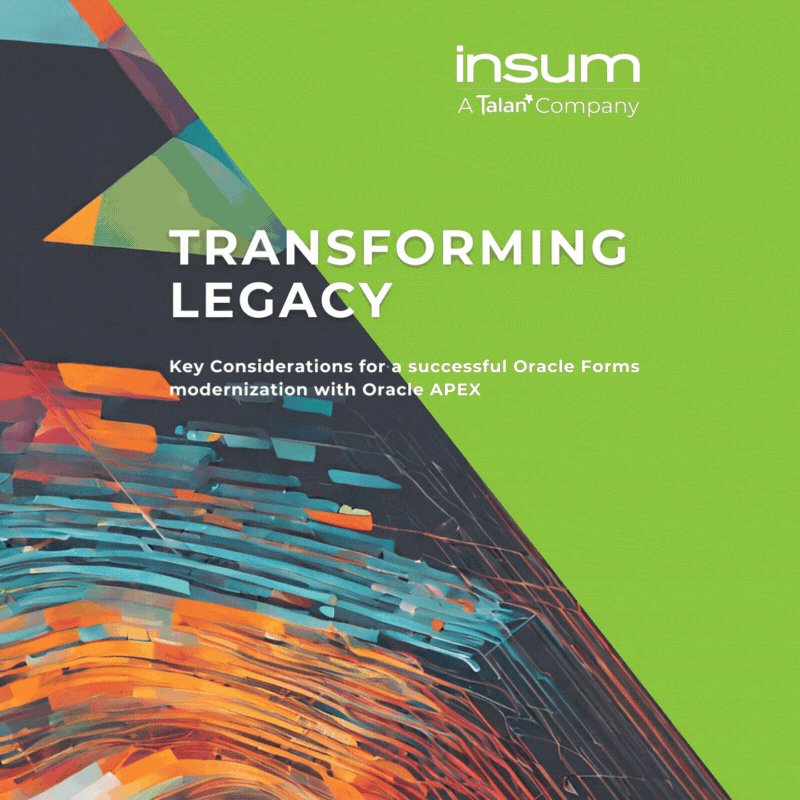Oracle Forms applications are the backbone of many organizations. They’ve evolved over time to fit the needs of order processing, shipping, finance, and more. They can be a model of efficiency. Yet, Forms at its core is still Client-Server technology, and only partially adapted to today’s web-based business reality. This is one of the main reasons many business administrators are looking for Forms migration options.
Oracle had to de-support Oracle Forms’ use of a Java plugin for web browsers due to quickly evolving browser technology. This issue was addressed, with a tool called Standalone Launcher which allows Forms 12c to operate “browserless”. Forms is better off with it, but it is much more in line with the client-server experience than a web one.
Oracle Forms Survey
A survey we did earlier this year during our Webinar entitled “Protect your Investment by Modernizing Oracle Forms” shows that a majority of Forms administrators believe a web-based user experience and functionality must play a role in the future of Oracle Forms.
With so many businesses still using Forms, Oracle is still active in supporting and updating it. But can your business afford to wait for Forms to catch up with the times? What about easily connecting to web services? What about implementing mobile applications, taking advantage of SaaS (Software as a Service) offerings, or real-time interactive reporting (more about Oracle Reports in an upcoming blog)? It might be a long wait.
So, what are the options available to an organization looking to replace Forms? Here are a few.
Forms Migration to Open Source Technology
Some organizations have chosen to replace Oracle Forms with open-source technology. For example, the LAMP approach: Linux, Apache, MySQL, PHP. These are license-free and can be used to build systems that are fully compatible with modern web technology. An open-source web development framework could help you generate web applications to replace your Forms applications. The disadvantage here is that there is no integration with Forms, and you are starting from scratch. Here’s a popular example of such a framework, called openxava which is based on your re-writing data structure and business logic code in Java.
Open source is free and without licensing fees, which is very attractive to the cost-conscious. In the above example, you could theoretically not only eliminate the licensing costs of your applications but those of your Oracle Database as well, if you were to migrate the Database to something like PostgreSQL, for example.
The main issue here, however, is that long-term support on such platforms is a question mark. Even the most popular open-source software risks being superseded. The result can be fewer upgrades and dwindling support.
It’s true that some open source software has large-manufacturer support. For example, Oracle supports MySQL. However, open-source tools often lack structure. The understanding and use of these tools will often depend on how well the specific technology suits the developer.
Forms Migration to ERP Systems (SAP, Oracle E-Business Suite, JD Edwards, etc.)
These standardized platforms, consisting of a bundled suite of business applications became very popular in the early 2000s. They’ve helped businesses grow, but they didn’t necessarily grow with all business needs. Companies using these systems are increasingly calling on software developers to extend their ERP’s capabilities. Each division of a large company can end up having custom needs outside the ERP’s parameters. This could come from managing new products, new technologies, new processes. ERPs may cover 80%-90% of your application needs, but that remaining 10%-20% is often what makes your business unique.
All in all, the associated costs of moving to an ERP are high. This can make sense if the new system covers your business functions. In my experience though, there is always something of Forms that isn’t. When this happens, you can use Oracle APEX to extend the ERP to integrate the necessary functionality. More on APEX later.
Forms Migration to Object-Oriented Development Technology
Some businesses change over to a different technology entirely, such as Java or .NET. But, does your development team have the time and talent to convert to a completely new application framework? Can they deal with suddenly being novices at a new programming language and having to continue to solve complex business problems with that limited knowledge? Can your company withstand this lost productivity and get safely through such a transition? If not, it can become a job for 3rd party technologists with the costs that this entails.
Custom Software
Many companies have application suites with Forms-like behavior created for them by 3rd parties using a combination of technologies. But, just as with open source technology, who knows how that will turn out in the long term? You might end up with a system that is just as difficult to maintain as your Forms system was.
Oracle’s Own Forms Modernization Solution
All of the above approaches are basically “From Scratch”. They put aside the efficiencies of Forms, and those of your developers. However, there is a way, thanks to Oracle, to reuse much of what your company has painstakingly developed over the years with Forms, to create thoroughly web-based applications.
It’s by using Oracle Application Express (APEX). APEX comes standard with the Oracle database and is already covered under your licensing program. As a no-cost option of the Oracle database, APEX allows you to create as many applications and have as many users as you want.
Best of all, it enables you to access the latest web technologies while utilizing your existing data model, business logic, and PL/SQL code.
APEX is a declarative application development platform that uses PL/SQL code. Unlike Forms though, its engine renders applications in real-time from data stored in tables on the database and displays them on a web browser. Whether you are running an application or developing one, it is done through a web browser.
Forms-APEX Coexistence
Instead of planning for an Oracle Forms replacement, with a full move over to a new system, why not consider a hybrid approach? It is entirely possible to mix Oracle Forms with Oracle APEX applications. You can run either of them at the same time in the same database. You can also go further and implement Single Sign-On (SSO) between both of them. This leverages existing Forms and Oracle Database Security.
Thanks to Oracle’s careful work, APEX and Forms can run on the same database using the same stored objects, with the same data model. Also, APEX has no middleware license costs. The Oracle Database license already covers your applications and your users. We call this coexistence the Forms-APEX blended solution.
No need for a big-bang approach: Modernize Progressively with a Web-Based Development Platform
Because APEX coexists so well with Oracle Forms, it allows you to proceed with your Forms Modernization projects in a phased approach, which keeps you in control of your time and budget. This also provides a smooth learning curve an integration for your IT staff and users.
PL/SQL developers who are just starting out with web technology can easily leverage an enormous palette of tools and web services with APEX. These tools can help them get up and running fast.
Conclusion
When it comes to choosing an alternative to Oracle Forms, there are many options, but it is always preferable not to start from scratch. After all, what company has the time for that? Keeping Oracle Forms and progressively replacing key Forms applications with a perfectly integrated development platform such as Oracle APEX is not only the most flexible option but the best supported as well.
Title photo credit: Joshua Coleman





